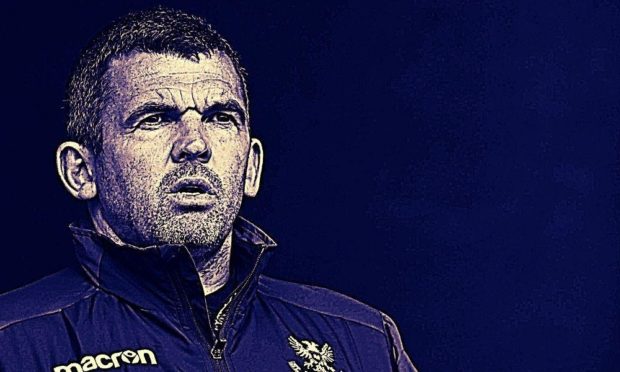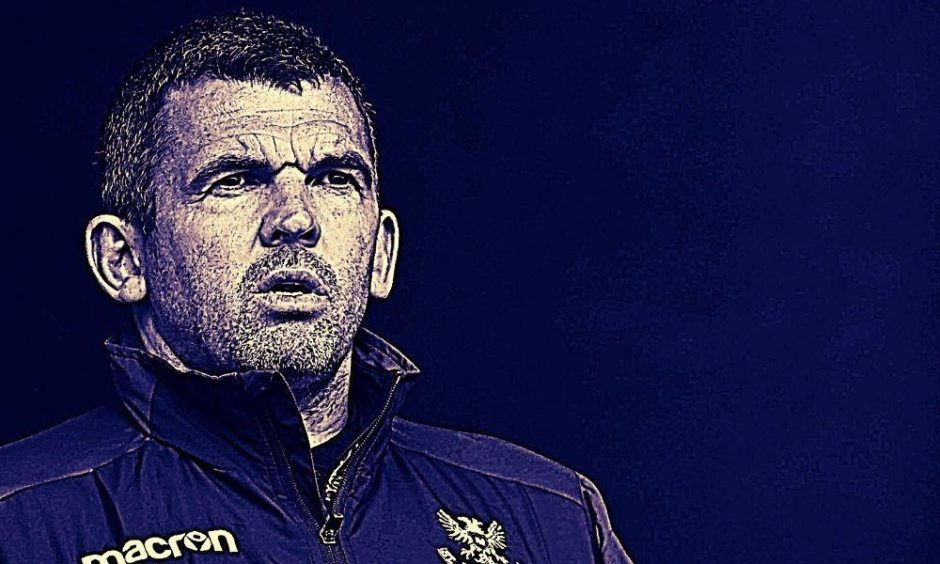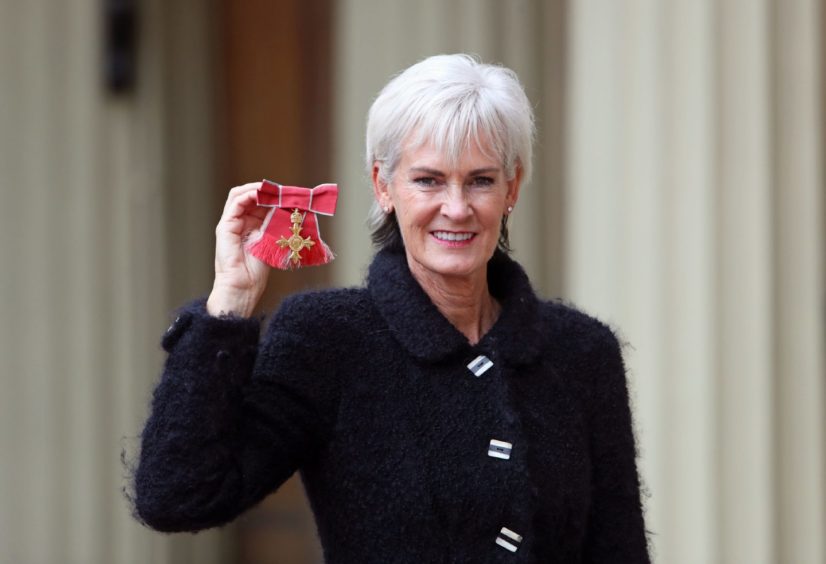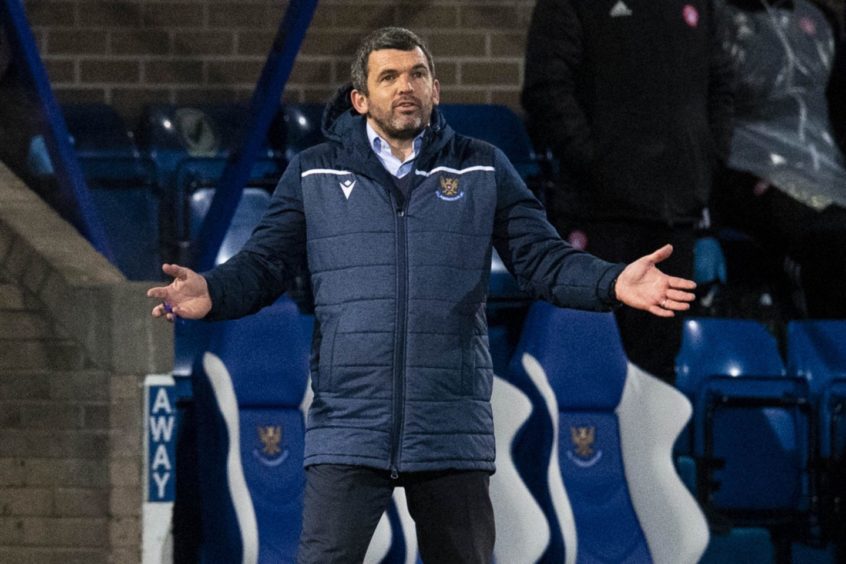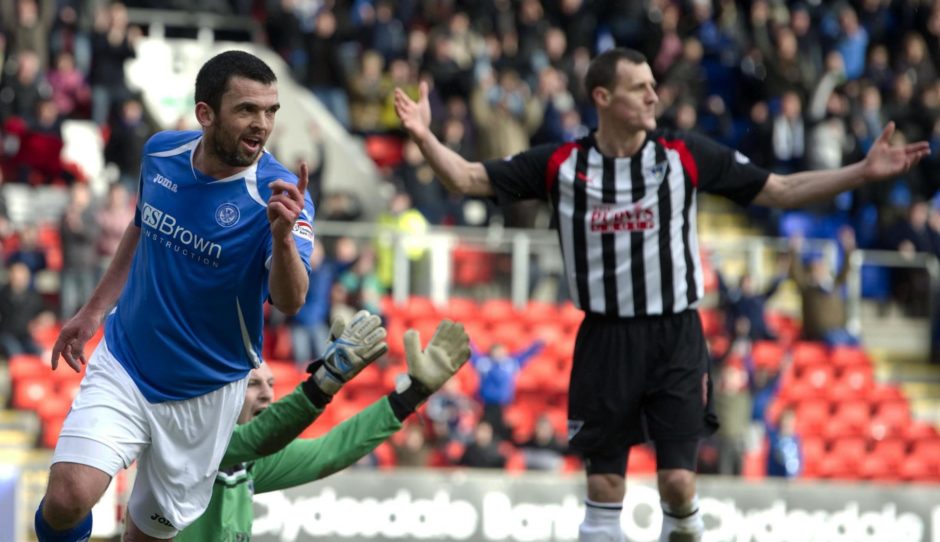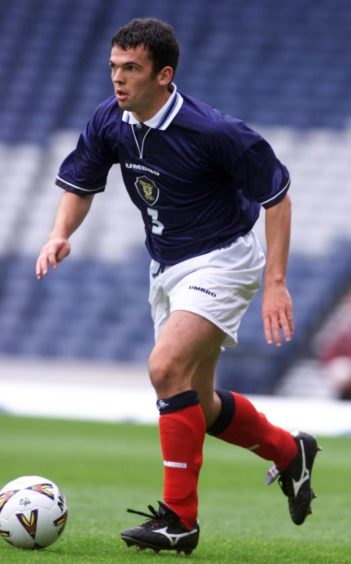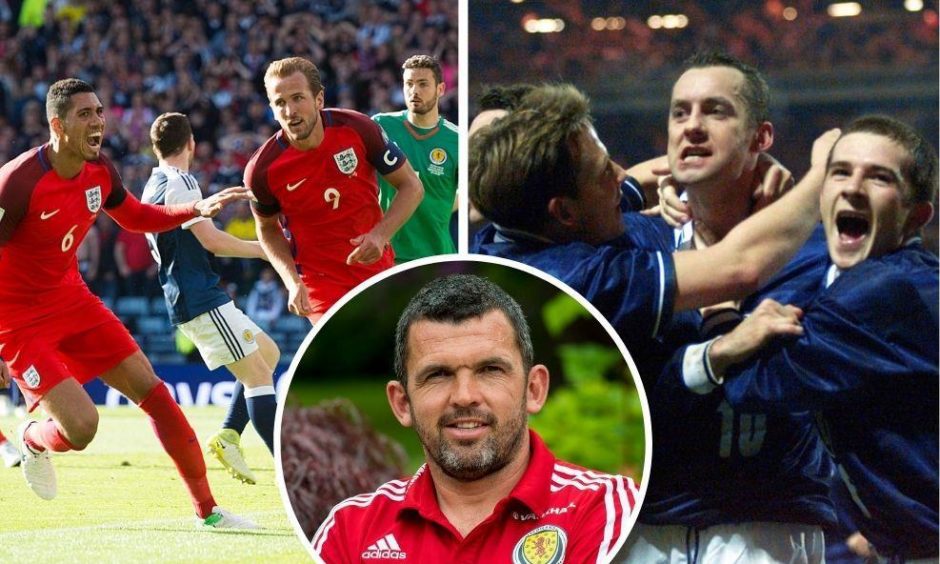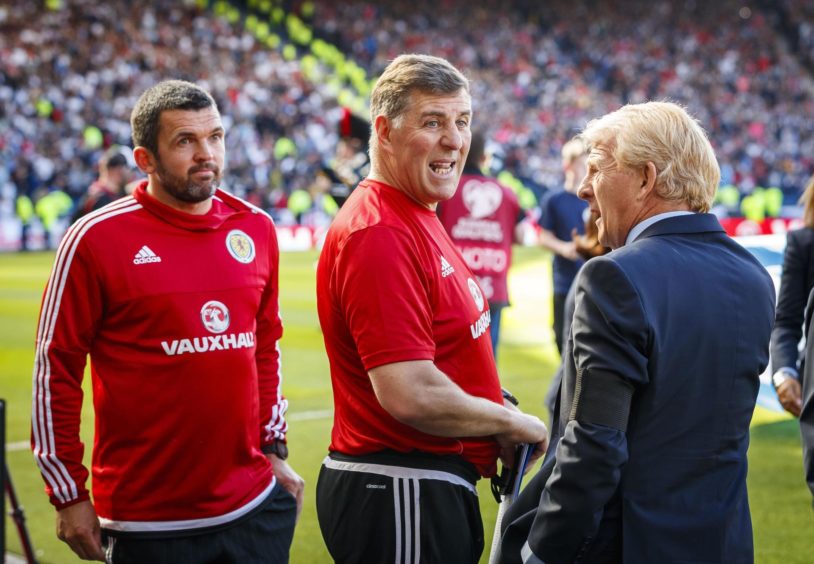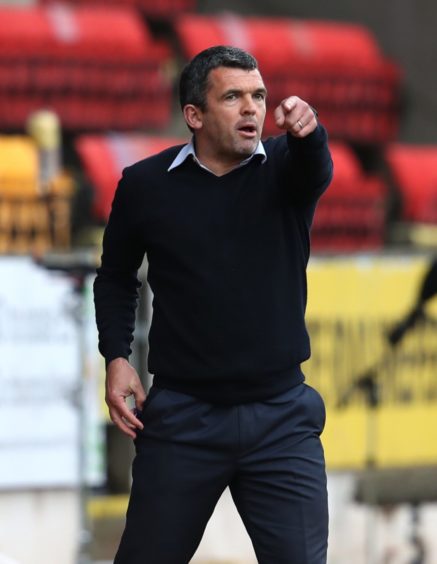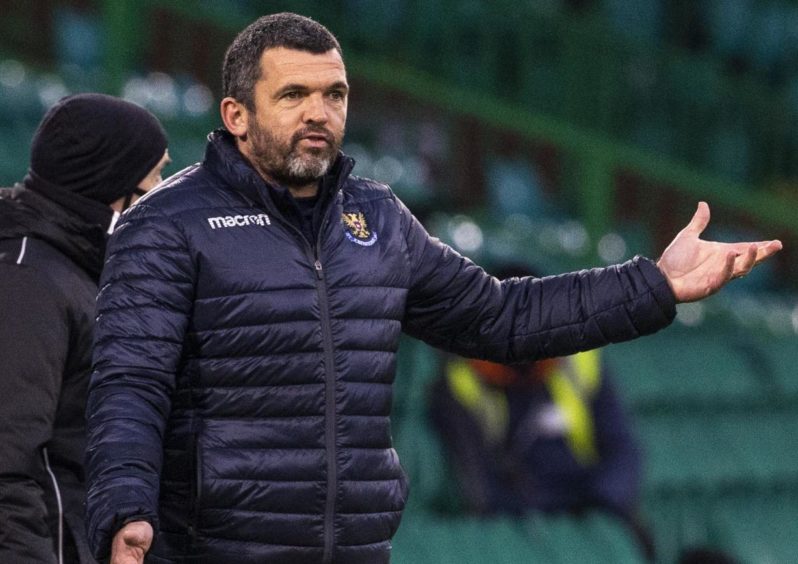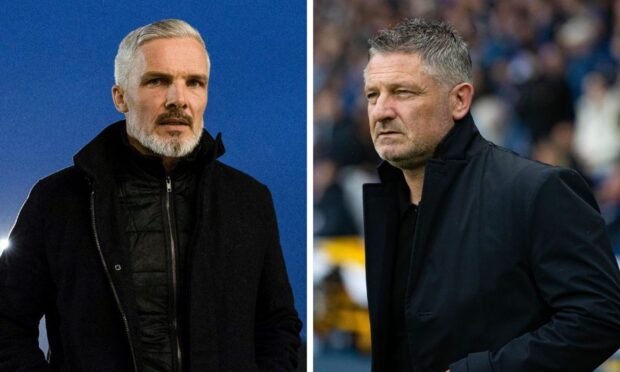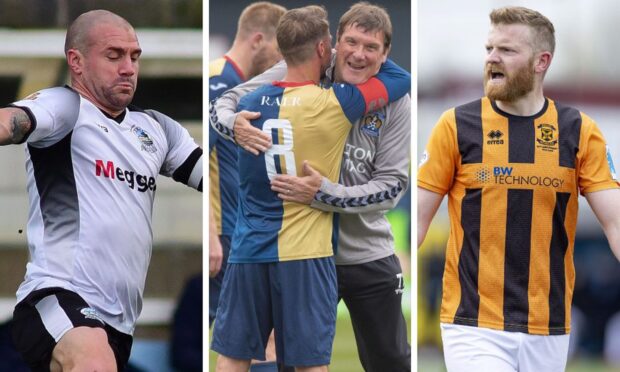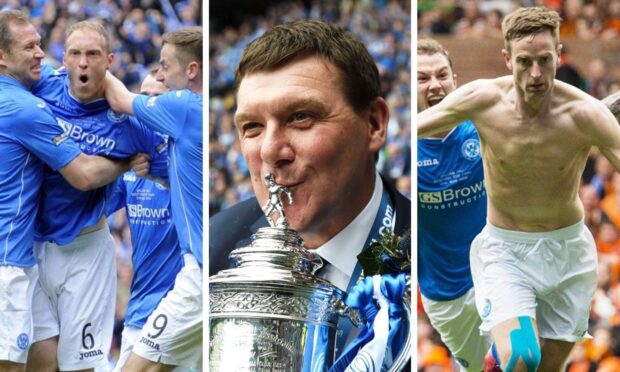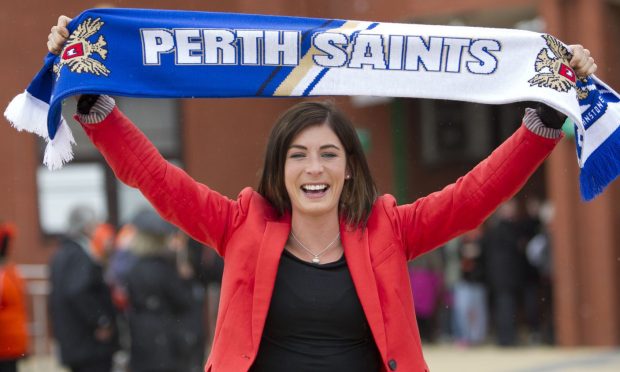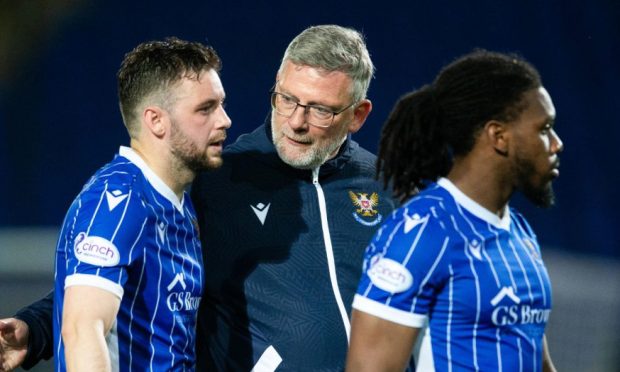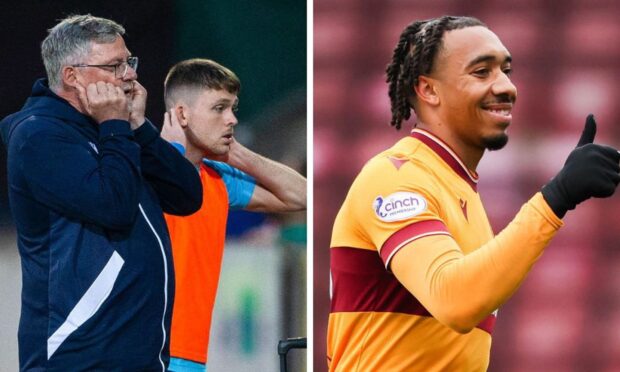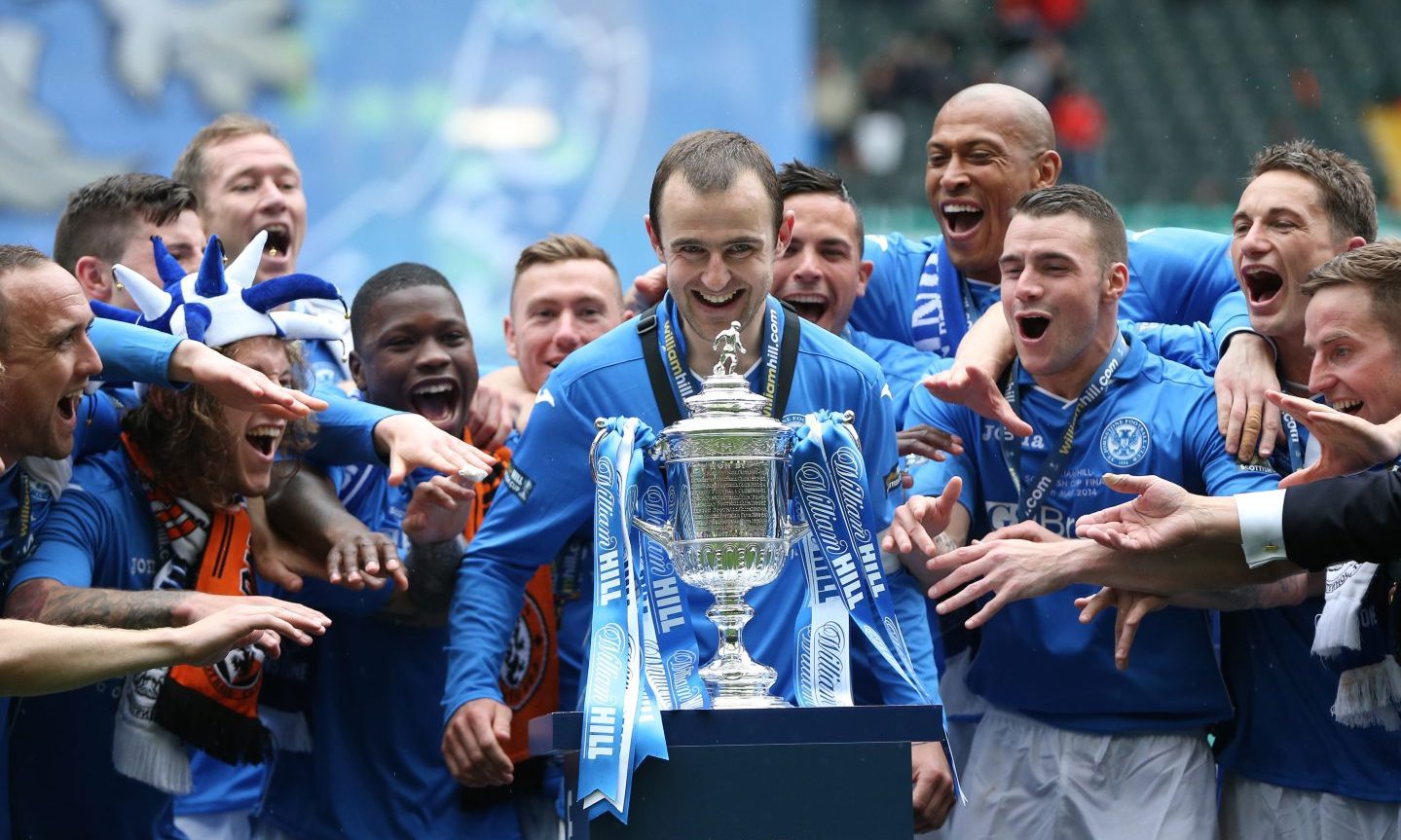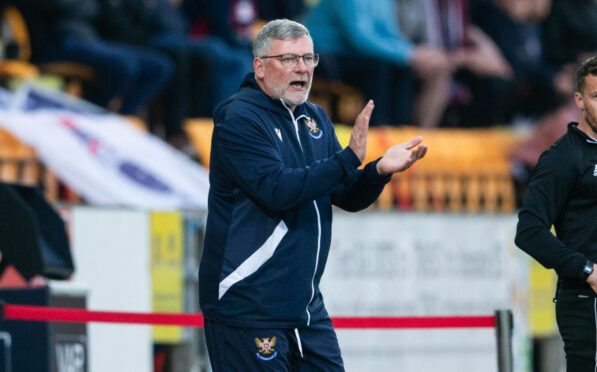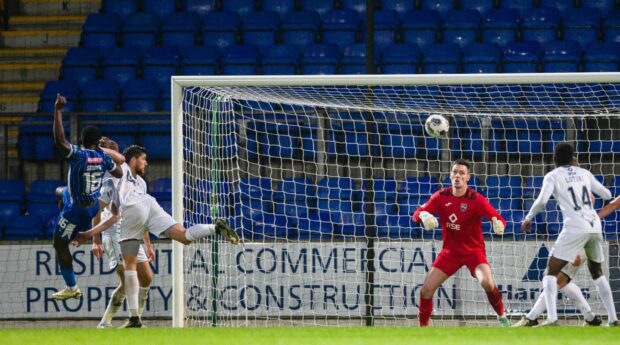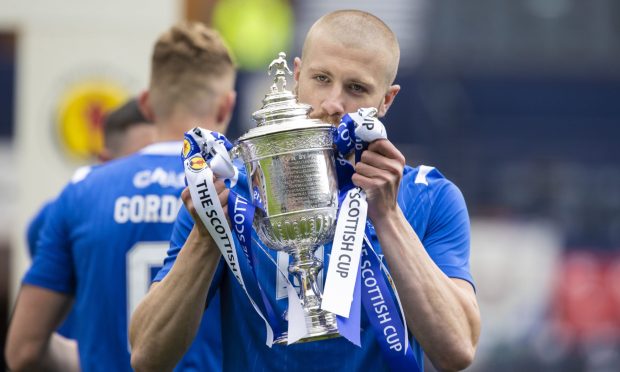Not all Saints are virtuous.
But for Callum Davidson, the enduring character traits that have formed the man are intrinsic to the accomplishments that have defined the athlete – and may soon lead to the canonizing of the manager.
Judy Murray, ably qualified to speak to both, looks back with the same fondness to the infectious personality and dedication of the multi-talented boy, for whom the sort of sporting choices most of us would envy were opening up, as she does to the racquet dexterity that caught her expert eye on the tennis courts of Dunblane.
Geoff Brown, the chairman who signed off his seven-figure transfer from St Johnstone to Blackburn Rovers, recalls the need to find him an agent and then hearing he shouldn’t have bothered because he wouldn’t be using one again.
Jim Weir and Rab Douglas talk of a team-mate who didn’t change.
And Craig Brown, the Scotland coach who first capped him for his country, keeps coming back to the word “honourable” in order to underline the player he remembers and the boss he admires from afar.
Tennis talent and getting to know the Murray family
The Callum who used to babysit Jamie and Andy Murray with his future wife Lorna was an enthusiast with charm and talent to match.
Judy always suspected that tennis was some way down his pecking order, behind football and golf, so it never became a source of frustration that the sport she loved wasn’t going to be the one he sought to shape a life around.
The raw ability and passion, though, were undeniable.
“I wouldn’t say that Callum played loads of tennis,” said Judy. “It was more squash and golf (he reached a handicap of plus-two and represented Scotland, when his peers were the likes of Alastair Forsyth).
“But he was always around the two clubs in Dunblane, which are literally right beside each other.
“He never took his tennis seriously, probably because there were other sports taking up his time that he enjoyed more.
“When he did come down he would want to show me his topspin serve or something else he’d worked out for himself. He’d have watched somebody do it on the telly, copied it and perfected it.
‘He was great to have around’
“I love when a kid comes to me and says: ‘I can do Pete Sampras’s serve,’ or :‘I can do Boris Becker’s serve,’ because you know it means they are studying the game.
“That’s becoming more and more a thing of the past unfortunately. Kids are more likely to go to endless coaching sessions where they’ll be told what to do, rather than exploring things for themselves.
“Teaching a topspin serve is actually really difficult but he didn’t need any help at all. He was so skilful and had that great hand-eye and hand-foot co-ordination that transfers across all sports.
“That was Callum in a nutshell. He was great to have around because he’s such good fun and would really get stuck in.”
As a coach and mentor, Judy has left her fingerprints on Scottish tennis like nobody before her. And she isn’t finished yet. But coaching the Dunblane High School boys’ team to a national title will forever occupy a special place in her heart.
“Callum wasn’t in the team that won the Scottish Boys in the end,” she said. “He’d have been number five or six. The boys who were in it were the ones who were at the tennis club all the time – it’s like football, if you don’t go to the training through the week, you’re not going to be in the team.
“But I have absolutely no doubt that if he had wanted to take tennis more seriously he could have been an exceptional player.
“It’s great that he still enjoys the sport – I actually saw him at the courts the other day with his wife, Lorna, playing away.”
In the mid-90s, when Davidson was making his mind up about which sport to dedicate himself to, a team environment would invariably hold more appeal than an individual one. And the principle remains applicable today, according to Judy.
“Obviously I don’t know what would have been going on in his mind but, if you think back to when he would have been making those choices, football would have had an infrastructure where you would be scouted and then where you could thrive,” said the former British Fed Cup captain, who has long been a champion of making sure Scotland fully capitalises on the never-to-be-repeated Murray brothers tennis boom.
Choice of sport for future St Johnstone manager
“Golf wouldn’t have been the same. You could play for your county, or country even, but nobody was taking you in and moulding you as would have happened at St Johnstone. It’s not as if we have a David Leadbetter academy on our doorstep like in Florida. Tennis is the same.
“At 16 and 17, an impressionable age, it’s really important to have friends around you for that social side of sport.
“A lot more needs to be done to create an environment where you can mix education, the social side and the actual sport. The team sports have an in-built camaraderie and infrastructure.
“I’m sure Callum would have weighed everything up. Tennis and golf would have been lonely in comparison to football back then I would imagine, more than you would maybe think.”
Judy added: “You’re more likely to gravitate to the one you’re best at but often the decision can be formed for you by an opportunity that comes your way or by one that doesn’t come your way.
“One of my friends was a good hockey player and tennis player. She wanted to go down the hockey route but when she wasn’t picked for a national team it so disappointed her that she transferred and went with tennis.
“It can be formed by circumstances, where you live, what facilities are available to you. So many different things. And there’s finance, of course.
“I’ve always said that if my kids had been exceptional footballers it would have cost me nothing, whereas in tennis or golf you end up carting your kids around the country, or in my case the world.
“It’s not just a case of going with the one you’re best at.”
We’ll never know if Callum Davidson the golfer, or even the Callum Davidson the tennis player, could have reached or surpassed the heights of Callum Davidson the footballer. What we do know is that it wasn’t until after a university education was curtailed that Callum Davidson the player, who was blending into the background at McDiarmid Park, was transformed into Callum Davidson the St Johnstone prize asset, who would command a transfer fee that remains a club record to this day.
You could argue that it was a more modest bid that came in for him before he was even a first team player that proved to be the most significant, however.
Former Saints chairman Brown recalled: “I was aware of Callum but it was only after (then reserve coach) Tommy Campbell went to Forfar and made us an offer of £4,000 that I started thinking: ‘OK, this guy must have some promise.’ It was Tommy who had brought him to the club.
“I told Tommy that we wouldn’t be accepting it even though I hadn’t even seen him play at that point.
“The first time I actually saw Callum play was on pre-season in Ireland. Luggy (Paul Sturrock) said to me after a game: ‘I think he’s not bad.’ ‘Not bad?’ I told him. ‘I think he’s a bit better than not bad!’
“That was the start of it.”
Team-mate recalls ‘Stuart Peace-type left-back’
It was the summer of 1996. Davidson had made his Saints debut two years earlier before attempting to juggle a civil engineering degree at Edinburgh University with his football. Not many recall that short, breakthrough first-team chapter, but club captain Weir certainly has good reason to.
“Callum scored on my St Johnstone debut against Ayr United,” he said.
“I think he actually played wide left rather than left-back. If I remember correctly he scored at the back post, following something up. It was a bit of a scrappy goal.
“He fell out of the team after that. I don’t think he played much at all for the rest of the season. You did kind of forget about him a bit. I know that his family wanted him to concentrate on his studies.
“He came back into the picture in the pre-season of the year we won the league. He was wanting to get himself up to peak fitness after not training full-time for a while.
“There was talk of him going to Forfar but he ended up getting stronger and stronger, signing a new deal and it proved to be a great decision for Callum and St Johnstone.
“In our promotion year he was battling Biscuits (Allan Preston) for the left-back place and Callum probably had the jersey for the majority of it.
“The way I remember him was as a Stuart Pearce-type left-back. He was one of those players who, when he went in for tackles in training, you’d look away because there was always the threat it could boil over.
“He certainly didn’t hold back. You wanted him in your team in training, not against you, that’s for sure.”
The trip to Ireland referenced by Brown proved to be career-enhancing. And a lesson Weir passed on to Davidson in one of the friendlies was integral to that.
Not dawdling back into position when your team needed you to sprint was the short and sharp message that found a receptive target.
“I can remember that,” said Weir.
“That was something I had drummed into me from when I was a young boy. The quicker you can get back, the better the chance you have to stop things happening. If you jog back, anything can happen. Don’t stop until the ball’s out of play or in the net.
“I still see it now when I’m watching a game and defenders are up the pitch for a corner, then they jog back when the other team is breaking. For me, it had to be a 100-yard sprint. That’s what I would be telling any young full-backs or centre-halves playing alongside me.
“Don’t be thumbing a lift back.
“That’s where the listening part came into it with Callum. You would only have to tell him once.
“We had a really good mix of players at St Johnstone at that time.
“There weren’t any bad eggs. You had your Edinburgh car that was pretty close, the Glasgow car and the Perth boys. So there was a wee bit of rivalry between the three. But we all looked after each other. It was a happy dressing room – and the fact that we were doing well helped that. We all socialised together.
“Callum and Philip Scott came into a group of 13 or 14 senior pros and they were comfortable in it and they were improving.
“It would have been a great environment for them but they were good listeners, which is really important.
“Trust me, it’s not always the case. There were boys like Keigan Parker who were hard to work with but Callum, Philip, Danny Griffin and Stuart McCluskey all listened and learned. They respected the senior players and they got the respect back because of that.”
Watching and hearing Davidson at work in his first season in charge as manager of Saints these last few months, there has been no escaping the emphasis he gives to his players on adapting quickly to changing circumstances around them, be that by providing an attacking option for the man on the ball, filling a defensive hole, or the many other facets of football that are executed to better effect if reactions are instantaneous.
“In your early days as a manager you try to manage on the touchline as if you’re on the park,” said Weir.
“You probably end up doing that less as the years go by because you start to realise when to leave the players to express themselves and let them make the decisions themselves.
“That change comes when you build up trust with your team, which will be happening for Callum now he’s deep into the season.
“Paul Sturrock didn’t need to shout at myself, Callum or the other defenders to get back in. We would just do it without thinking.
“That’s what will be happening with this Saints team.”
Judy would be some way out of her comfort zone dissecting Davidson’s work on a training ground or pitch-side but she is well-positioned to offer an opinion on his coaching roots.
“He understands a lot about skills development,” she said. “He’ll be able to look back at the advantages he had of having two sporty parents, one who was a PE teacher at the High School, who encouraged him and his brother Andrew to do all the sports that were available in a town with great facilities.
“I’m sure he’ll bring that appreciation of the importance of investing in skills to his role at St Johnstone, particularly with the young players he’s helping to develop.
“Great people skills and being fun to be around are also very important.”
Making the move away from St Johnstone
If the early years at St Johnstone were a slow burn for Davidson, once he got into the team in ’96/’97, helped the club back into the Premier League that season and then to establish themselves in the top flight in the first few months of the following one, there was a blaze intense enough to catch the attention of scouts from far and wide.
He only played 45 times – the last of those appearances being a 2-0 win against Rangers – before Blackburn Rovers, champions of England three years earlier, put their money on the McDiarmid Park table.
Unlike when the £4,000 offer came in from Angus, Brown knew the time was right to strike a deal.
“We hadn’t been in the Premier League for long when Blackburn came in for him,” he said.
“Callum was only a regular for the promotion season and the first few months of the following one.
“I’ll always remember Luggy saying: ‘I bet you don’t get a million for him.’ I said: ‘I bet you I will.’ So we had a tenner bet on it, which I’m still waiting on!
“I spoke to Roy Hodgson (Blackburn manager) and they were looking to get him for one-and-a-half million. I had £2 million in my mind and we finished up in between at £1.75 million, with £50,000 per Scotland cap for the first five caps.
“That’s what we settled on and that’s what we ended up getting.
“If you look at prices today, it’s nothing. But it was a good deal back then, especially for a left-back.
“We’d agreed £1 million with Derby for Danny Griffin a season or so before. I wouldn’t say I had that in my mind. I just wanted to get as much as I could. I ended up putting Callum in touch with an agent because he didn’t have one but I don’t think he ever used another again after that deal.”
Saints fans would have loved to see Davidson called up for his country before he made the move south but circumstances conspired against that.
“Without doubt he’s the best left-back St Johnstone have had,” said Brown. “The most complete player.
“He had a lot in his make-up. He could run, tackle, over-lap, cross a ball, shoot and he was quick. He was so sturdy and strong, as well as fearless.
“Callum picked up injuries over his career but no bloody wonder with the way he went into a tackle! He was either going to hit or be hit and that meant sometimes he would be the one coming off worst.
“Sloop (Sturrock’s assistant, John Blackley) did a lot of work with the defenders and would have played a big part in his development.
“It was a different world then. You were a proper left-back, playing against proper wingers. He was playing in a good team of course, which obviously helps.
“The Scotland team was a much harder team to break into back then and remember, he hadn’t played for long with us in the Premier League.
“There have been others I can think of who were more unfairly overlooked than Callum while they’ve been here. Dave Mackay is the best example of that. For all the time he was at St Johnstone he barely had a bad game and Scotland have struggled to find a right-back.”
It was an injury that kept him out of the Blackburn side after signing that was an injury that scuppered his chances of being selected for Scotland’s World Cup squad for France ’98.
And the man doing the picking acknowledged as much.
“Callum was definitely in my thoughts,” said then national team head coach, Brown.
“We knew he was a very good player when he was at St Johnstone and then he got a big money move to Blackburn Rovers.
“It’s easy to say now that I’d have selected him if he’d been fully fit but I’m sure I would have.
“He was an out-and-out left-back and we didn’t have a lot of them.
“He was the perfect man for the wide left position in the 3-5-2 I played. He’d have been up and down that side all day.
“We could play Christian Dailly there but Christian wasn’t a natural left-back. There was Tosh McKinlay as well but Callum would have been an obvious contender, no doubt.
“Tosh winds me up that he never got a cap until he went to Celtic and Callum could maybe argue that he should have been called up when he was still at St Johnstone. I can take it on the chin. Even Stevie Clarke still jokes with me that I didn’t pick him!
“My answer is that we played 10 qualifiers for Euro ‘96 and 10 qualifiers for France ‘98 and in each of those campaigns we lost just three goals.
“The point is – it was a very strong defence that full-backs around that time were trying to break into.”
National service
Davidson would have to wait until a few months after that tournament, and the start of the next European Championship qualifying campaign, for the first of his 19 Scotland games.
He has gone on record to thank Ally McCoist for helping dissuade the referee Constantin Dan Zotta, in Glaswegian Romanian, to only bring out a yellow card for the type of full-blooded challenge that managers and supporters loved.
“I remember the tackle but I don’t remember McCoist’s part in it all,” said Brown, who gave Davidson his debut with 20 minutes left in place of Colin Calderwood. “Though that bit doesn’t surprise me!
“It was the kind of tackle you want to see from a full-back. I put in plenty of those myself when I was a player. That was all I could do, mind you. Callum had much more to his repertoire.”
Had he enjoyed a career not punctuated as routinely by muscle injuries, the repertoire Brown speaks of would have yielded far more matches for Scotland, possibly getting Davidson to the 50-cap mark and into the Hampden Hall of Fame.
That one of his 19 was the last time the Scots beat England at Wembley is quite the consolation, mind you.
“Callum was a very accomplished footballer,” said Brown.
“And the biggest kudos I can give him is when speaking about our two-leg play-off against England for the Euro 2000 championships.
“I played Paul Ritchie at left-back and not Callum in the first game at Hampden. I put him man for man against Beckham and Paul actually had a good game because Beckham didn’t really do much at all in their 2-0 win.
“By no stretch of the imagination was Paul an attacking full-back so for the second game at Wembley I thought that we had to be positive and try something different, so I picked Callum.
“He was magnificent. It ended up that Beckham was marking him rather than the other way around!
“He was so purposeful and played a part in the goal, of course.
“My two best players that night were the two youngest – one was Barry Ferguson and the other was Callum Davidson.
“Callum did become injury-prone which was really unfortunate. He would have played for Scotland on many more occasions had it not been for that.”
Given their international careers overlapped, it is a surprising statistical quirk that goalkeeper Rab Douglas, who also reached 19 appearances for Scotland, and Davidson only played together once.
The occasion was Berti Vogts’ second competitive international, a 2-0 win in Iceland that followed the traumatic and infamous draw against the Faroe Islands.
“If you’d asked me to guess, I would have thought Callum would have been in the 30s or 40s for caps,” said Douglas. “At least we had a 100% record as team-mates!”
The two actually go a lot further back. Back to when Sunday’s Betfred Cup final opponents were Meadowbank Thistle, not Livingston. Douglas had been picked up from Forth Wanderers juniors via the wonderfully-named amateur club Symington Tinto and Davidson was invited to train with the Edinburgh part-timers, with St Johnstone’s blessing, while he was a student in the city.
“Donald Park and George Mackie would have been in charge when Callum was in training with us at Meadowbank,” said Douglas, now a coach himself in the lower leagues at Arbroath. “It was them who signed me.
“Even then he had the attitude and fitness levels you would want to see from someone starting out in the game who wants to improve as a player and get a career out of the game.
“It’s always great to see someone like that be a success. And look at him now.
“When you’re a teenager who is splitting time between studying and football, coming into a club with part-time professionals, you have to have something about you.
“He kept his head down, did really well and then went back to St Johnstone and kicked on from there. Probably coming into Meadowbank would have been great for him. I’m sure he looks back to that time with fond memories.
“There were a good group of young pros coming through and a good group of senior pros to guide them. I was one of the rough and ready ones.”
Whether you come to football with a trade behind you as a trained bricklayer like Douglas did, or as a young man with an academic and multi-sports background like Davidson, not being a stereotype academy kid has in-built character-forming advantages.
“It makes you appreciate the game a lot more,” said Douglas, who would still be covered in brick dust as Davidson was tasked with firing shots at him.
“Wee things like new strips, new boots, win bonuses, being part of a dressing room. You don’t take any of it for granted.
“I sometimes think that too many players who come through academy set-ups believe they have a divine right to have a career. That was never the case for me and it was the same for Callum. His dedication and application has certainly served him well.”
Rival for the Scotland jersey
Having two Scottish left-backs playing for English top-flight clubs, and what best to do with them, wasn’t a selection issue that began with Andy Robertson and Kieran Tierney. In his pomp, Davidson had Gary Naysmith as a like-for-like rival for his favoured position.
“Callum probably had a wee bit more pace than Gary,” said Douglas.
“They were very similar in a lot of ways, though, to be honest – hardy defenders who could get up and down the park.
“Callum went to Blackburn and Leicester and Gary went to Everton. Both had very good careers in England.
“Calum probably picked up more injuries, which is reflected in the number of caps they got (Naysmith finished on 46).
“It was a bit like the Robertson-Tierney situation. You could probably say Callum was more like Tierney and Gary like Robertson.
“That’s what international football is like. You can be crying out for someone in a different position and end up with two players who give you high quality on one side.”
Brown got to pick Davidson a good deal more to play in the white and dark blue of Preston North End than he did in the dark blue and white of Scotland. And it was through their club manager and player relationship that one of the grandees of the game north of the border got the close-up measure of the man.
“He’s an honourable guy,” said Brown. “That’s the word that best describes him. When I was taking him to Preston I never saw an agent. I just spoke to Callum.
“That’s unusual, believe me.
“He wasn’t in any way motivated by money, that’s for sure. He was very well liked at Preston. They love their Scots there.
“My captain was the current assistant manager at Motherwell, Chris Lucketti, and the next in line was the current Motherwell manager, Graham Alexander. Callum was another one of the leaders in that dressing room.
“I’ll tell you who else held in him very high regard – Roy Hodgson.
“Roy phoned me to ask about Callum before he signed him for Blackburn and I gave him a glowing recommendation.
“Roy’s the kind of guy who will get back in touch to let you know how a player has fitted in and he told me that it couldn’t have gone any better for Callum at Blackburn. He thought the world of him.
“Obviously I haven’t seen Callum as a manager on the training ground or on a match day but I can see his team, I can see how they are set-up and I can see how they play.
“He’s the kind of manager players will want to play for.
“Alex Ferguson summed it up perfectly – a football manager is a very powerful position and you can only lose that power in two ways. That’s by being incompetent or being dishonest.
“Players will respect you if you know what you’re talking about and you’re honest. Tell a player a lie and you’ll never be forgiven in a dressing room.
“I can’t imagine Callum falling down on either of those fronts.
“There are some players you have in your teams who you think are certainties to become managers – usually strong characters, full of personality, like Willie Miller and Alex McLeish, for example.
“You maybe wouldn’t describe Callum like that but it certainly doesn’t surprise me that he’s gone down this route or that he’s doing so well.”
‘He has the nous and presence you need’
Brown has no time for inverted snobbery in football, with Davidson the latest manager to back up one of his theories.
“Intelligence is one of the best attributes you can have as a manager,” he said.
“Going back to my era as a club manager at Clyde, the best manager in the country was Terry Christie. He was highly intelligent.
“Callum can be put into that category – so can Jack Ross – and it’s a great asset.
“You’ll find some people who will condemn young football guys because they’re intelligent but I’ve never understood that.
“That intelligence came through when Callum got his tactics right for the semi-final and it will serve him well for the final. He has the nous and the presence you need.
“I’ve got the highest regard for Callum. First and foremost, he’s outstanding as an individual and he’s developing into an outstanding young manager. I’ll send him a wee message before the game and I really hope that he can lead St Johnstone to another cup win.”
That hope runs even deeper for Weir, a Saints player of over a decade, who will be putting his faith in good things happening to good people at Hampden.
“I knew Callum wouldn’t be the type who would change as a person when he left the club all those years ago,” he said. “It was the same with Philip Scott. They both got big moves to England but were the same people who played at St Johnstone.
“When I was out with an Achilles injury not long after his transfer to Blackburn, I was driving down to Lilleshall for rehab for another two weeks of intense treatment after breaking down. It’s in the Stoke area.
“I’d kept in touch with Callum and I was breaking up the journey on the road when I went to see him. We sat and watched St Johnstone get beaten 7-0 by Rangers.
“I remember when I got to Lilleshall I was taking a bit of stick about why I was wanting to get back fit in time for the next Rangers game – which was the one I made my comeback in and scored in.”
The Murrays are famously a family of Hibs supporters who wrestled with conflicting emotions a few weeks ago for Saints’ semi-final. Allegiances are clear-cut this weekend, though.
“We just ignored that semi-final!” joked Judy.
“Callum gets on great with Jamie and Andy and they have a lot of banter together – usually around football and fantasy football. None of them have forgotten their roots. They’ve known each other for a long, long time.
“The boys would always watch football on the TV when they were young. I wouldn’t watch many games but if Callum was playing, I would. When you’ve got one of your own to support it makes a difference.
“When Jamie comes back up, Callum will be one of the first people on his list to try and meet up with. They’ll get a few holes of golf in. They love the chat, talking about their sporting experiences, and they’re competitive with each other.
“We’ll all be wanting St Johnstone to win the final. It would be fabulous for Callum to do that in his first season as a manager.”
Uplifting community pride isn’t unique to Dunblane, but the poignancy of it in this part of old Perthshire is unparalleled for reasons that need no repeating. It won’t be an Australian Open final, as had become the norm at this time of the year, but on Sunday, locals will get the chance to get behind one of their own again.
“It’s a special thing,” said Judy. “It really does happen.
“I’ve said it many times – the success Jamie and Andy have had makes people think of Dunblane for very positive reasons rather than sad ones, which is so important.
“In Andy’s year at school, there was a girl in his class who played for Scotland at football, a boy who went on to play for Scotland at rugby, Katharine Brown who became Miss Scotland and Miss UK, a Scottish Master Butcher of the Year, somebody who played ice hockey for Scotland. They were all in the same class. It was uncanny.”
An eerie Hampden Park will be empty but, from the people in football who have been part of his career, to the people of Dunblane who know him longest and best, Callum Davidson won’t be lacking support.
